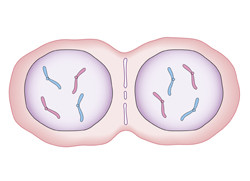Chromosome restructuring during mitosis
Eukaryotic cells possess multiple large linear chromosomes, which localise inside the cell's nucleus. During interphase, when the cell is not dividing, the DNA is in its least condensed state and appears loosely and homogenously distributed throughout the nucleus. During cell division, chromosomes need to form compact and rod-shaped bodies, so that one copy of the genome can be moved to each of the nascent daughter cells. The EU-funded Marie-Curie 'Assembly and function of the chromosome periphery during mitosis' (CHROMOSOME PERIPHERY) project was initiated to elucidate molecular mechanisms involved during cell cycle-dependent chromosome re-organisation. Researchers worked on establishing a detailed map of the proteins targeted to the chromosome periphery and axis in human cells. The localisation of a chromosome axis protein, topoisomerase II alpha, was determined in dividing (mitotic) and unsynchronised HeLa cells, using a biochemical approach (chromatin immunoprecipitation followed by sequencing), which led to the identification of about 4000 binding sites on DNA. This approach might be extended to chromosome periphery proteins. Three-dimensional confocal live-cell microscopy was used for imaging analysis of eight chromosome periphery proteins in mitotic cells. This study yielded a spatial and temporal map of chromosome peripheral assembly. Researchers also developed screening approaches for the functional relevance of chromosome peripheral components during mitosis. Solid-state transfection screening plates have been generated and first pilot experiments indicated feasibility of the screening. Altogether this project obtained data that provides insights into how the chromosome axis and peripheral domains contribute to mitotic chromosome formation.







